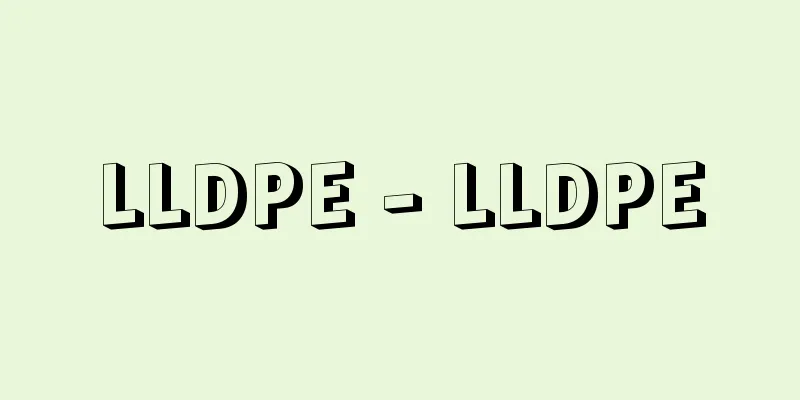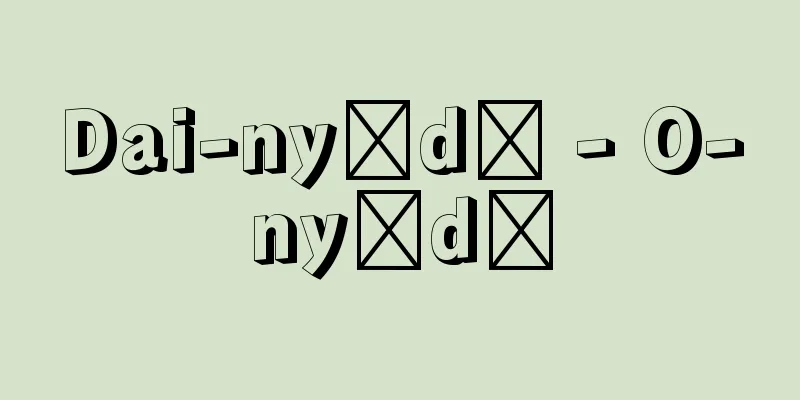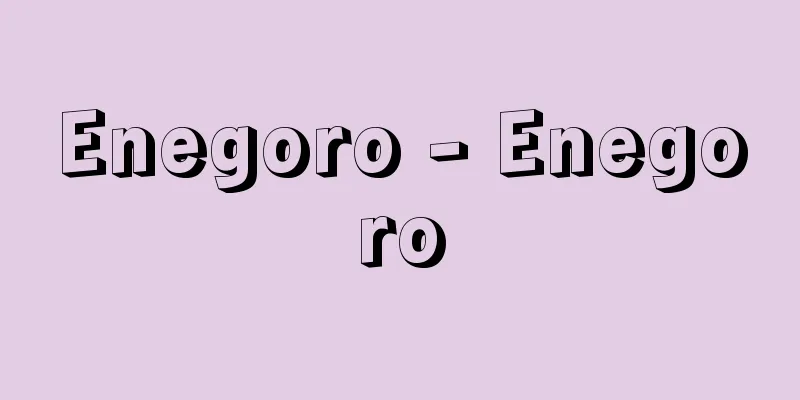Meninges -

|
The meninges are connective tissue membranes that cover the brain and spinal cord; the membrane that covers the brain is called the meninges, and the membrane that covers the spinal cord is called the spinal meninges. The brain is protected inside the skull, and the spinal cord is protected inside the spinal canal, but both are also completely enclosed by the meninges. There are three types of meninges: from the outermost to the outermost, they are the dura mater, arachnoid mater, and pia mater. Of these, the arachnoid mater and pia mater are considered to be a single membrane, and are sometimes collectively referred to as the pia mater in the broad sense. [Kazuyo Shimai] Dura materThe outermost layer of the brain's meninges, the dura mater, is an extremely thick membrane made up of two lobes (the outer and inner lobes). The outer lobe functions as the periosteum of the skull, and is in close contact with the inner lobe. However, in the dural venous sinuses, which ultimately collect venous blood from the brain, the outer and inner lobes of the dura mater are separated into two to form the walls of the dural venous sinuses. There is a small gap between the skull and the dura mater, called the epidural space. It contains lymphatic fluid, veins, and fatty tissue. The dura mater runs from the surface of the brain along the major divisions of the brain in a plate-like shape, and serves to hold the brain in place. These are called the falx cerebri, falx cerebellum, tentorium cerebelli, and membrane of the septum sellae. The falx cerebellum runs between the left and right cerebral hemispheres (internal fissure) in the shape of a sickle with the blade pointing downwards. The falx cerebellum runs between the left and right cerebellar hemispheres, but is shallowly sickle-shaped. The tentorium cerebelli runs between the occipital lobe of the cerebrum and the cerebellum, covering the upper surface of the cerebellum in a tent shape, with the occipital lobe resting on top of it. The membrane of the septum sellae is a membrane that covers the upper surface of the sella turcica of the sphenoid bone, transitioning from the tentorium cerebelli, and is pierced by the pituitary stalk. The lateral edges of these dura mater attach to the inner surface of the skull and form part of the dural venous sinuses. The spinal dura mater is different from the cerebral dura mater. The spinal dura mater that comes from the brain splits into two when it passes through the foramen magnum, with the outer lobe acting as the periosteum of the spinal canal and the inner lobe becoming the original spinal dura mater. Therefore, in the case of the spinal cord, the epidural space is the space formed between the two spinal dura mater. The inner lobe encases the spinal cord in a bag-like shape, and when it closes at the level of the second or third sacral vertebra, it becomes thread-like (spinal dura filaments), which descends and attaches to the back of the coccyx. [Kazuyo Shimai] Arachnoid membraneThe arachnoid mater is made of thin connective tissue that does not contain blood vessels. The outer surface of the arachnoid mater is covered with endothelial-like cells and is attached to the dura mater, but there is a narrow gap between the arachnoid mater and the dura mater called the subdural space, through which lymphatic fluid flows. Thin fiber bundles of connective tissue extend from the inner surface of the arachnoid mater and are loosely connected to the pia mater. The arachnoid mater does not extend into the recesses or grooves on the surface of the brain or spinal cord, so it is clearly separated from the pia mater in those areas, leaving a wide gap between the two. This space is called the subarachnoid space. This space is connected to the fourth ventricle through the lateral and median openings of the fourth ventricle in the rhomboid fossa, so cerebrospinal fluid also flows into the subarachnoid space. The particularly wide part of this space is called the subarachnoid cistern. There are several subarachnoid cisterns on the surface of the brain, and the largest of these is the cerebellomedullary cistern (cisterna magna) between the cerebellum and medulla oblongata. Clinically, it is used for cerebrospinal fluid examinations (especially in children). In the spinal cord, the pia mater ends at the lower end of the first lumbar vertebra together with the spinal cord, but the arachnoid membrane closes at the level of the third sacral vertebra, so there is a wide subarachnoid space at the level of the third to fourth lumbar vertebra. For this reason, so-called lumbar puncture is performed at this level. In other words, if a needle is inserted into the subarachnoid space between the third and fourth (or fourth and fifth) lumbar vertebrae, cerebrospinal fluid can be collected. The arachnoid membrane projects granular projections from its outer surface toward the dura mater, fuses with the dura mater, and protrudes into the dural venous sinus. These are called arachnoid granules, and are considered to be a device that absorbs cerebrospinal fluid from the subarachnoid space and guides it to the dural venous sinus. The subarachnoid space contains many arteries, making it prone to subarachnoid hemorrhage. [Kazuyo Shimai] Pia materThe pia mater is a delicate connective tissue membrane similar to the arachnoid mater, rich in blood vessels, which covers the entire surface of the brain and spinal cord, penetrating into all grooves and fissures. Numerous blood vessels exist among the connective tissue of the pia mater, but small blood vessels branch off from it and enter the substance of the brain and spinal cord, where they soon become capillaries. The pia mater penetrates into the ventricles, and together with the layer of ventricular epithelial cells of the ventricular walls, forms the choroid tissue of the fourth ventricle, the third ventricle, and the lateral ventricle. These choroid tissues form the highly vascular choroid plexus, which secretes cerebrospinal fluid. The spinal pia mater also adheres closely to the surface of the spinal cord, penetrating into all grooves. At the end of the spinal cord, it becomes thread-like and extends downward. This is called the filum terminale, and is attached to the posterior surface of the coccyx. The spinal pia mater also gives off a triangular dentate ligament from the outside of the spinal cord, the apex of which is fixed to the dura mater, fixing the spinal cord to the vertebral column. There are approximately 20 pairs of dentate ligaments along the entire length of the spinal cord. [Kazuyo Shimai] Source: Shogakukan Encyclopedia Nipponica About Encyclopedia Nipponica Information | Legend |
|
脳と脊髄(せきずい)を覆っている結合組織膜で、脳の部分を覆う膜を脳髄膜、脊髄を覆う膜を脊髄膜という。脳は頭蓋(とうがい)骨の中に、脊髄は脊柱管の中に保護されているが、さらに、両者とも髄膜によって完全に包まれている。髄膜には3種類の膜がある。すなわち、最外側から順に、硬膜、クモ膜(くも膜)、軟膜である。このうち、クモ膜と軟膜は単一膜と考えられ、両者をあわせて広義の軟膜とよぶこともある。 [嶋井和世] 硬膜脳髄膜のうち、最外側にある脳硬膜はきわめて厚い膜で2葉(外葉と内葉)からなる。外葉は頭蓋骨では骨膜の役をしており、内葉と外葉とは密着している。しかし、脳の静脈血を最終的に集める硬膜静脈洞では、硬膜の外葉と内葉とは2枚に分かれて硬膜静脈洞の壁をつくっている。 頭蓋骨と硬膜との間にはわずかな間隙(かんげき)があり、これを硬膜上腔(くう)という。ここにはリンパ液があるほか、静脈や脂肪組織も含まれる。脳硬膜は脳の表面から脳の大きな分かれ目に沿って、板状となって入り込み、脳を固定する役をしている。これらは大脳鎌(かま)、小脳鎌、小脳テント、鞍隔(あんかく)膜とよばれている。大脳鎌は左右の大脳半球の間(大脳縦裂)に刃を下に向けた鎌状となって入り込んでいる。小脳鎌は左右の小脳半球の間に入るが、これは浅い鎌状をしている。小脳テントは大脳の後頭葉と小脳との間に入り込み、小脳の上面をテント状に覆い、その上に後頭葉がのっている。鞍隔膜は蝶形(ちょうけい)骨のトルコ鞍の上面を覆う膜で、小脳テントから移行しており、下垂体茎が貫いている。これらの硬膜の外側縁は頭蓋骨の内面に付着するとともに、硬膜静脈洞を形成する部分となる。 脊髄硬膜は脳硬膜とは異なる。脳から移行してきた脊髄硬膜は大後頭孔(こう)を抜けると2枚に分かれ、外葉は脊柱管の骨膜の役をし、内葉は本来の脊髄硬膜となる。したがって、脊髄の場合における硬膜上腔は、2枚の脊髄硬膜の間にできる腔である。内葉は脊髄を袋状に包み、第2ないし第3仙椎(せんつい)の高さで閉じると糸状(脊髄硬膜糸)になり、そのまま下降して尾骨の後ろ側に付着する。 [嶋井和世] クモ膜クモ膜は血管を含まない薄い結合組織からできている。クモ膜の外表面は内皮様細胞に覆われて硬膜に付着しているが、硬膜との間には狭い硬膜下腔とよぶ間隙があり、ここにはリンパ液が流れている。クモ膜内面からは結合組織性の細い線維束が出ていて軟膜と緩く結合している。クモ膜は、脳や脊髄の表面では陥凹部や溝の内部まで入らないので、その部分では軟膜との間がはっきり分かれて、両者間に広い間隙ができる。これをクモ膜下腔とよぶ。この腔は菱形窩(りょうけいか)に存在する第四脳室外側口と第四脳室正中口を通じて第四脳室と連絡しているため、クモ膜下腔にも脳脊髄液が流れることとなる。この腔がとくに広い部分をクモ膜下槽とよぶ。脳の表面にはクモ膜下槽がいくつか存在するが、このうち、小脳と延髄の間にある小脳延髄槽(大槽)が最大のクモ膜下槽であり、臨床的には脳脊髄液の検査(とくに小児の場合に多い)に使う部位となる。また、脊髄では、軟膜が脊髄といっしょに第1腰椎(ようつい)下端の高さで終わっているが、クモ膜は第3仙椎の高さで閉じているため、第3~第4腰椎の高さでは、広いクモ膜下腔が存在する。このため、いわゆる腰椎穿刺(せんし)はこの高さで行われる。すなわち、第3~第4(または第4~第5)腰椎間で穿針をクモ膜下腔に入れると、脳脊髄液を採取することができる。クモ膜は、その外面から硬膜に向かって顆粒(かりゅう)状の突起を出して硬膜と融合し、硬膜静脈洞の部分に突出する。これをクモ膜顆粒とよび、クモ膜下腔の脳脊髄液を吸収し硬膜静脈洞に導く装置とされている。クモ膜下腔には動脈が多く走るため、クモ膜下出血の原因となりやすい。 [嶋井和世] 軟膜軟膜はクモ膜と同じような繊細な結合組織の膜で、豊富な血管をもち、脳や脊髄の全表面を覆い、どのような溝、裂にも侵入する。軟膜の結合組織間にも多数の血管が存在するが、これから分かれた細い血管は脳や脊髄の実質に侵入し、すぐに毛細血管になる。脳軟膜は脳室まで侵入し、脳室壁の脳室上皮細胞層といっしょになって第四脳室脈絡組織、第三脳室脈絡組織、および側脳室脈絡組織を形成している。これらの脈絡組織は著しく血管に富む脈絡叢(そう)を形成している。この脈絡叢から脳脊髄液が分泌される。脊髄軟膜も脊髄表面に密着し、どの溝にも侵入する。脊髄末端では糸状となり、下方に伸びている。これを終糸とよび、尾骨の後面についている。また、脊髄軟膜は脊髄の外側から三角状の歯状靭帯(じんたい)を出し、その頂点の部分が硬膜に固着して脊髄を脊柱に固定している。歯状靭帯は脊髄全長で20対前後存在している。 [嶋井和世] 出典 小学館 日本大百科全書(ニッポニカ)日本大百科全書(ニッポニカ)について 情報 | 凡例 |
Recommend
Gyokuchi Ginsha - Gyokuchi Ginsha
…He gained popularity for his simple style of poe...
Quy Nhon (English spelling)
The capital of Binh Dinh Province in central Vietn...
α-MSH - Alpha MS H
…Three types of MSH, α, β and γ, have been isolat...
"Kabuki Screen"
...In other words, in hand-painted genre painting...
Water ball - Suiton
〘Noun〙 ("Ton" is the Tang-Song pronuncia...
Milker (English spelling)
Milking machine. A device that creates a vacuum in...
International Energy Agency
…Abbreviation for International Energy Agency. Es...
Saiki [city] - Saiki
A city in the southeastern part of Oita Prefecture...
Suomi
…Official name = Republic of FinlandSuomen Tasava...
Eastman Color
→Color film Source : Heibonsha Encyclopedia About ...
Kamisato
...Population: 7,476 (1995). The town name is der...
Tree guardian - Kimaburi
〘Noun〙① A variation of the word "kimamori (tr...
Eutectic alloy - eutectic alloy
…Normal steel is a two-phase alloy of ferrite and...
Gadsden, J.
...refers to the purchase of territory by the Uni...
Belgorod (English spelling) Белгород/Belgorod
The capital of Belgorod Oblast in the western par...









